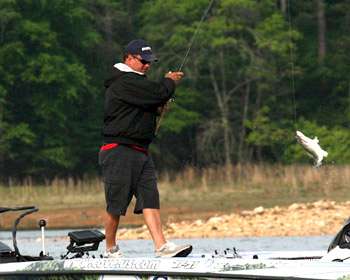
When it comes to finding active bass on large bodies of water, one of the standard mantras often heard from pro anglers is, "If you find the forage, you've found the bass." Depending on the region, that forage may include crawfish, bluegill, threadfin or gizzard shad, gobies, and — if you're fishing in the southeast — blueback herring.
South Carolina's Davy Hite is very familiar with targeting bass that are keying on blueback herring. Having posted multiple Top 10 finishes on lakes where herring are the predominant forage for bass, he has learned some valuable lessons about the blueback connection.
"The blueback herring has been a great asset to lakes that have an established population. Bass become very aggressive when they're around them," Hite explains. "The bass absolutely love bluebacks, which have suddenly become the No. 1 forage for bass and stripers in lakes that have them." Hite points to popular bass fishing destinations like lakes Murray, Clarks Hill, Hartwell, and Russell as top examples of waters where bluebacks have become a vital part of forage for bass.
At first glance, the task seems simple: Find blueback; catch bass. However, Hite is quick to point out that the first part of the equation isn't as easy as it seems. "The location of the bluebacks really depends on the time of the year," Hite allows. "In many situations, sloping main lake points are a good place to start, but that's not always the case. You really have to pay attention to your depthfinder, and watch for birds that are diving to find out where blueback herring and bass are located."
Even after finding a school of baitfish, Hite's next step is to decipher exactly what species of baitfish he has detected. On a locator, herring and shad look the same, so Hite uses his eyes and a little luck to find the herring. I just try to find big groups of baitfish because that's always a good place to start, he explains. "Sometimes I'll snag one by accident, or I might actually see a herring swimming. That's how I tell what type of baitfish I'm around."
As if that doesn't seem tough enough, blueback have an affinity for packing up and leaving town at a moment's notice. "The main thing is trying to find where the blueback are located. They could be up in 2 to 3 feet of water, or out in 30 feet. When the herring move, the bass move with them," says Hite.
After finding bluebacks, Hite matches the hatch to take advantage of feeding bass.
"I try to imitate blueback herring with my lure presentation. I also try to keep in mind that a bass will swim a long way to find herring, and when it does, it will be very aggressive. I will have a tremendous killer instinct — I've seen it first hand."
Hite relies on a combination of topwater baits, lipless crankbaits, and deep diving crankbaits to take advantage of aggressive bass. "When the bass come to the surface chasing the herring, they become really active, so it is important to get your bait in the mix immediately. For that reason, I use a longer rod, around 7 feet, so I can make a long cast to the school," Hite explains.
After a school of bass is charged up, the action can be fast and furious. "A lot of times, you'll hook a schooling bass that was chasing blueback, and four or five other bass will follow the hooked fish back to the boat," Hite explains. "I have another rod close by and immediately pick it up after landing the initial fish. In a schooling situation, I'll often have a double rig tied on with a topwater bait on the top and a trailer hook with some sort of soft plastic, and I'll catch two at a time."
(Provided exclusively to BASS Insider by Z3 Media)




